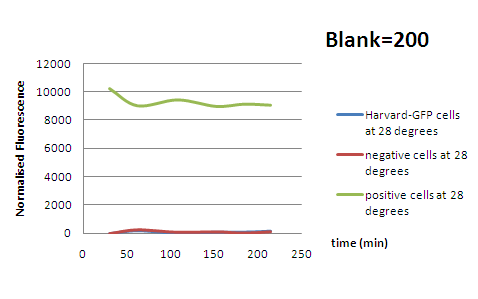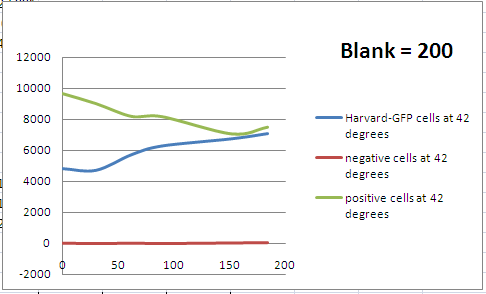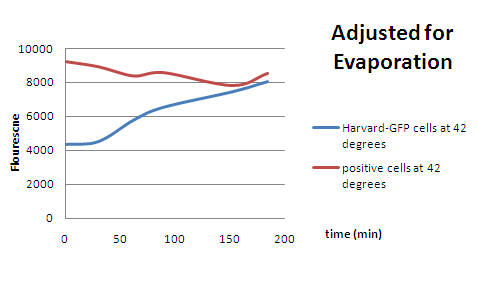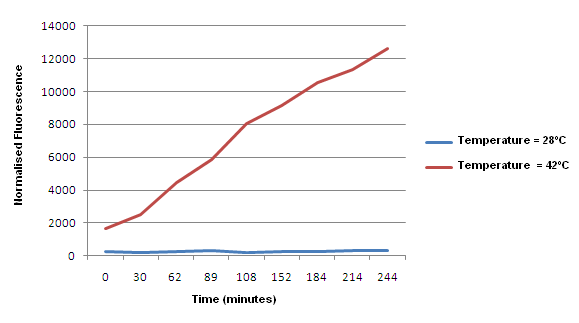Team:Imperial College London/Wetlab/Results/Thermoinduction
From 2009.igem.org
(→Background) |
(→Background) |
||
| Line 8: | Line 8: | ||
We have ligated the thermoinduction promoter system [http://partsregistry.org/wiki/index.php/Part:BBa_K098995 BBa_K098995] to the GFP reporter to form our own testing construct [http://partsregistry.org/wiki/index.php/Part:BBa_K200022 BBa_K200022] . This allows us to follow thermoinduction of the promoter by changes in GFP fluorescence <br> | We have ligated the thermoinduction promoter system [http://partsregistry.org/wiki/index.php/Part:BBa_K098995 BBa_K098995] to the GFP reporter to form our own testing construct [http://partsregistry.org/wiki/index.php/Part:BBa_K200022 BBa_K200022] . This allows us to follow thermoinduction of the promoter by changes in GFP fluorescence <br> | ||
| - | + | <br> | |
This analysis also serves to characterise the subpart [http://partsregistry.org/wiki/index.php/Part:BBa_K098995 BBa_K098995] submitted by Harvard 08. <br> | This analysis also serves to characterise the subpart [http://partsregistry.org/wiki/index.php/Part:BBa_K098995 BBa_K098995] submitted by Harvard 08. <br> | ||
| - | + | <br> | |
==Aim== | ==Aim== | ||
Revision as of 00:17, 22 October 2009

Contents |
Thermoinduction system activity variation with temperature
Background
We are using the thermoinduction promoter system [http://partsregistry.org/wiki/index.php/Part:BBa_K098995 BBa_K098995] to activate module 3 (genome deletion) when the temperature is raised to 42 degrees.
We have ligated the thermoinduction promoter system [http://partsregistry.org/wiki/index.php/Part:BBa_K098995 BBa_K098995] to the GFP reporter to form our own testing construct [http://partsregistry.org/wiki/index.php/Part:BBa_K200022 BBa_K200022] . This allows us to follow thermoinduction of the promoter by changes in GFP fluorescence
This analysis also serves to characterise the subpart [http://partsregistry.org/wiki/index.php/Part:BBa_K098995 BBa_K098995] submitted by Harvard 08.
Aim
To investigate the behaviour of the lamda-cI thermoinducible promoter and show repression at the low temperature of 28°C and activation when the temperature is raised to 42°C.
Experimental method
Cells were grown at the 2 different temperatures of 28°C and 42°C. There was in addition a set of cells that were shifted from 28°C to 42°C so that we could characterise the change in GFP fluorescence during the transition between temperatures.
In order to characterize the thermoinducible promoter properly, we have used 2 sets of control cells:
- Positive control cells: Containing the [http://partsregistry.org/Part:BBa_I13522 BBa_I13522], acting as a baseline comparison by constitutively expressing GFP.
- Negative control cells: These contain the thermoinducible promoter on its own ( [http://partsregistry.org/Part:BBa_K098995 BBa_K098995]) with no GFP attached to it. These serve as cells without any fluorescence.
Results
Variation in the blank
The level of variation in the blank absorbance and fluorescence is within a narrow range. However, we cannot immediately assume that it is constant, given that we are dealing with relatively low baseline values.
In order to take into account this variation, the growth rate and fluorescence output of the curves was computed for different values within the range, and the purpose was to decide if this variation had a significant impact.
Click below for more information on blank variation analysis:
Absorbance blank variation
Fluorescence blank variation
Variation in absorbance
Understanding of the fluorescence data requires normalization with cell growth data, in the form of optical density (absorbance). Therefore, we proceed to analyse the OD600 data obtained first.
This includes recording the variation in absorbance of the blank well (containing only the M9 medium) and normalizing absorbance data against the latter to spot ay possible trends in growth rate variations at different temperatures.
We have made an analysis of the difference in growth rate of the cells at 28 and 42 degrees.
More information on our analysis of absorbance
Variation in fluorescence
At 28ºC

Figure 3: Fluorescence at 28 ºC
- At 28 ºC, we can clearly see that the fluorescence is repressed, relative to the constitutive promoter (positive control).
- The blue line is low, and fluorescence output is low. Therefore, the promoter is repressing downstream genes.
At 42ºC

Figure 4: Fluorescence results at 42 degrees

Figure 5: Fluorescence results at 42 degrees (corrected for effect of evaporation)
- In figure 4, we can observe that fluorescence levels drift towards a steady state and are no longer low (as in the 28 ºC case).
- This plot starts at a value of 4000 fluorescence units because the cultures were shifted from 28 ºC to 42 ºC overnight.
- In figure 5 we have accounted for the effects of evaporation (as it happens due to an increase in temperature) so we can now see the positive control at a relatively constant level. This was not the case in figure 4, where evaporation was not taken into account. This, as mentioned earlier, could also be the reason of variation in the blank results.
- There is a clear difference with the 28 ºC case, showing that indeed, at higher temperatures the downstream genes from the promoter are no longer repressed.
Conclusion

The characterization of the thermoinducible promoter is as follows:
- At 28 ºC, there is no fluorescence (GFP) output because its expression is repressed
- At 42 ºC, we can observe an increase in fluorescence (GFP) output,as its expression is no longer repressed
Hence, we can conclude that in the E.ncapsulator system, an increase in temperature de-represses the expression of downstream genes, which trigger the genome deletion phase.
 "
"



